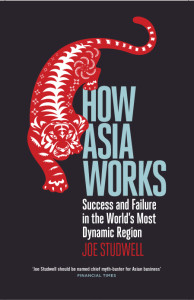 China’s economy, and its meteoric rise, has been dissected many times before and continues to be a subject that deserves constant examination. The challenge of financial reform facing the Chinese Government was one of the key topics at the European Chamber’s annual conference, where a consensus emerged that a key condition for carrying out the necessary reforms is an emphasis on rule of law.
China’s economy, and its meteoric rise, has been dissected many times before and continues to be a subject that deserves constant examination. The challenge of financial reform facing the Chinese Government was one of the key topics at the European Chamber’s annual conference, where a consensus emerged that a key condition for carrying out the necessary reforms is an emphasis on rule of law.
In Joe Studwell’s latest book How Asia Works: Success and Failure in the World’s Most Dynamic Region, he closely examines the growth of the economies of Asian countries. In the article below he expands on the themes that he discusses in his book in relation to China.
Studwell says that while the agrarian reforms and successful development of an export-based manufacturing model, coupled with tightly-controlled capital flows, has seen China climb to become the world’s second largest economy (with first place now firmly in its sights), it may not be enough to keep it there. To maintain their position, China needs to focus on efficiency and shift its attention to developing solid institutions.
The size of China’s population means that the Middle Kingdom’s economic development has truly shaken the world. But the economic policies behind the country’s takeoff are remarkably similar to those pursued earlier by Japan, South Korea, and Taiwan.
The starting point of success in all these places — and what primed industrialisation — was land reform programmes after the Second World War that turned agriculture into a form of super high-yield gardening.
Backed by agronomic training campaigns, rural credit, and marketing arrangements that ensured farmers — not middlemen — captured profits, yields and output in Japan, Korea and Taiwan increased by between half and three quarters in 10−15 years. After China reversed out of its Maoist-collectivisation cul-de-sac in the late 1970s, its grain output jumped by more than a third, even as household farming was still being implemented; it then rose much further.
The surpluses created in agriculture provided initial capital for development strategies with an acute focus on the manufacturing industry. Manufacturing is essential to developmental success because it is the best way to utilise surplus labour migrating from farming.
Parents stayed on farms, their kids left, and factories became the secondary schools of successful developing states in East Asia. They took low-skilled workers and trained them on the job. In many exportable services there is a hurdle to participation — you cannot write software until you know software code. But in manufacturing workers add value from day one by working with machines.
The requirement for more highly-trained workers in a manufacturing economy is limited to small numbers of technicians who organise production lines based on machines that are bought on the world market (and are then reverse engineered into cheaper, and sometimes superior, local variants). Through manufacturing, a developing country leverages its minority of skilled personnel. Or, looked at the other way, it circumvents the limitations of its average worker.
Equally important is the fact that manufactured products are much more freely traded in our world than services. This is partly because of trade barriers erected by rich countries and partly due to practical obstacles. Manufactured goods are packed in containers and sent one way to anyone who will pay.
The opposite of a manufacturing approach to development is India’s services-based strategy. Today, India’s vaunted information technology sector employs three million people out of a population of 1.2 billion.
Not entirely kindly, I call India’s economic development strategy ‘the emancipation of the posh Indian’. It works fine for graduates of the elite Indian Institutes of Technology who go to work for Infosys and Tata Consultancy Services, but not so well for the average Indian. The idea that India will replicate the broad-based development success of China and Northeast Asia is a fantasy.
However, there is nothing original about Northeast Asia’s manufacturing-based development. When China today builds plants of huge scale to reduce unit costs below what other producers can achieve, it is repeating the trick that Germany played on Britain in the 19th century. In turn the United States did the same thing to trump both Britain and Germany. Japan used the approach to become the first rich non-white country; Taiwan and South Korea targeted Japanese manufacturing competitors with factories that were bigger and newer.
The main contribution of north-east Asian states to this game has been to improve returns on subsidies given to manufacturers to support their development. Most of these subsidies do not go direct to production and fall in the grey areas of international trade law: free land, cheap electricity, government orders, centralised bargaining to cut costs of technology acquisition, and abundant (though, contrary to popular opinion, not always cheap) credit.
Crucially, all the subsidies are loosely linked to export performance, which gives governments a clear sense of whether their investment is yielding globally competitive manufacturing. The failed industrialisation strategies of Southeast Asia, Latin America and Africa have been characterised more than anything by the failure to impose this ‘export discipline’.
The main mechanism for such discipline is financial systems. North-east Asian states maintained restrictions on international capital movements, and closely controlled banks, so the allocation of money was determined by the core developmental objective of technological learning.
The IMF and the World Bank, by contrast, encouraged countries to lift capital controls and open up financial systems so that money was allocated on the basis of short-run profits (in line with the ‘efficiency’ economics of rich countries). Southeast Asia listened, but Northeast Asia did not. One manifestation of this today is that among the major East Asian economies, the ones that are industrially most backwards — the Philippines, Indonesia and Thailand — are the ones with the best-performing stock markets.
Land reform, export-oriented manufacturing and closely controlled finance, however, are not a panacea. They can make a country quite rich very quickly, but then the economics of efficiency and good institutions are needed to keep development going. Japan’s 25-year hiatus, or the condition of Italy and France in Europe, are the proof of that pudding.
The bigger lesson is that — contrary to what many economists claim — there are two kinds of economics. There is the kind that fosters technological learning to enable countries to switch to more value-adding activities (akin to an education process); and there is the kind that fosters greater efficiency and becomes ever more important once the basics are in place (akin to life as an adult). The East Asian success stories have become masters of the first kind of economics, but they know little about the second.
Joe Studwell’s latest book, How Asia Works: Success and Failure in the World’s Most Dynamic Region, is published by Profile. A version of this article was first published in the UK’s Sunday Times and is published here by permission of the author.



Recent Comments